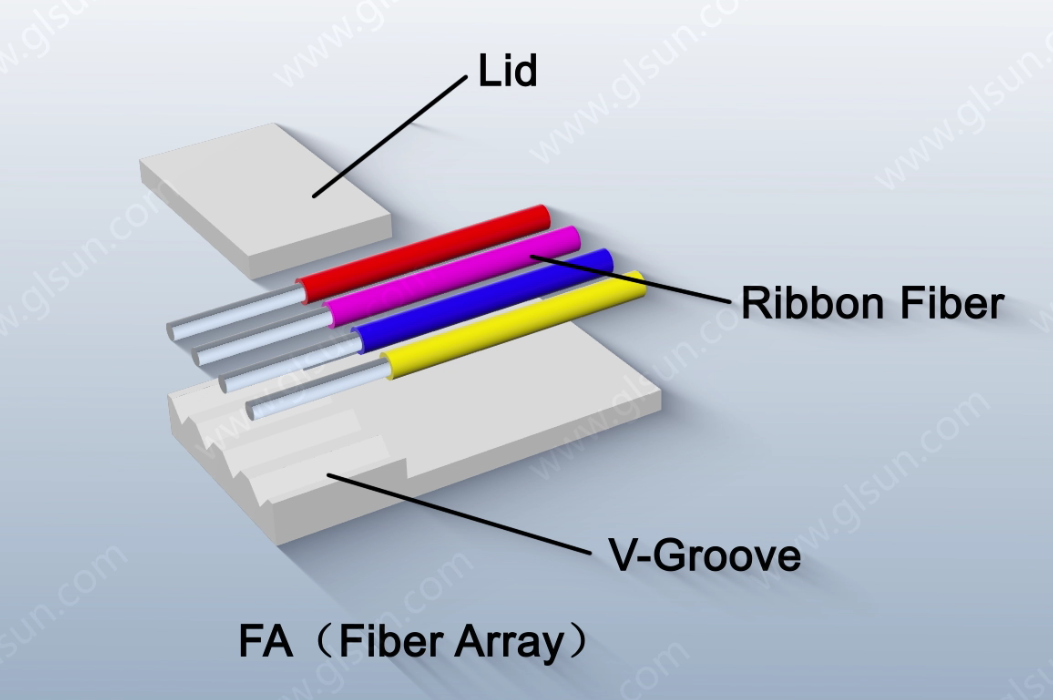What Is a Fiber Array (FA)?
2025-04-24
As optical networks scale to support higher data rates and denser channel counts, the need for precise and reliable fiber alignment grows more critical. Fiber Arrays (FAs) are foundational components that enable this alignment by organizing multiple optical fibers into a compact and highly accurate format. Whether integrated into planar lightwave circuits (PLCs), optical switches, or high-speed transceivers, FAs play a vital role in ensuring low-loss, high-density connectivity between fiber and photonic devices.
A Fiber Array (FA) is an optical component that aligns multiple optical fibers in a highly precise manner. Typically, the fibers are arranged in a straight line (1D) or in a matrix format (2D) to enable mass fusion splicing, coupling with optical chips, or integration into photonic devices. The primary function of an FA is to ensure accurate core-to-core alignment among multiple fibers or between fibers and other optical components, thereby minimizing insertion loss and maximizing signal integrity.
FAs are crucial for high-density optical systems, where many channels must be managed simultaneously within compact physical dimensions. Their use improves assembly efficiency, consistency, and performance, especially in applications requiring scalable parallel optical interconnects.
Structure of a Fiber Array
The construction of a Fiber Array is a marvel of precision engineering, designed to ensure optimal performance in demanding optical environments. The key components of a typical Fiber Array include:
1. Lid
The lid is a protective cover, usually made of glass, ceramic, or a similar material, that secures the optical fibers in place. The lid ensures that the fibers remain aligned within the array and protects them from environmental factors such as dust, moisture, and mechanical stress. The lid is carefully bonded to the substrate to maintain the structural integrity of the FA.
2. V-Groove Substrate
The V-groove substrate is the heart of the Fiber Array, providing precise alignment for the optical fibers. This substrate, typically made from silicon, glass, or ceramic, features a series of V-shaped grooves etched with sub-micron accuracy. Each groove holds an individual optical fiber, ensuring that the fibers are positioned with high precision to align with the optical input/output of connected devices. The V-groove design minimizes misalignment and ensures consistent performance across all channels.
3. Ribbon Fiber
Ribbon fiber refers to a bundle of multiple optical fibers arranged in a flat, ribbon-like configuration. In Fiber Arrays, ribbon fibers are commonly used to achieve high-density connections. The fibers are stripped of their protective coatings and placed into the V-grooves, where they are secured using adhesive or epoxy. Ribbon fibers enable the simultaneous alignment of multiple channels, making them ideal for applications requiring parallel data transmission.
4. Adhesive and Bonding Materials
High-quality adhesives, such as UV-curable epoxy, are used to bond the fibers, V-groove substrate, and lid together. These materials must exhibit low shrinkage, high thermal stability, and excellent optical transparency to avoid signal degradation. The bonding process is critical to maintaining the mechanical and optical integrity of the Fiber Array.
5. Polished Endface
The endface of the Fiber Array, where the fibers interface with other optical components, is meticulously polished to achieve a smooth, flat surface. This polishing minimizes back-reflection and ensures efficient light coupling. The endface may also be angled (e.g., 8°) to further reduce reflection losses in specific applications.
The combination of these components results in a robust and precise Fiber Array capable of supporting high-performance optical systems.

Types of Fiber Arrays
Fiber Arrays are available in various configurations to meet the diverse needs of optical communication systems. The main types include:
1D Fiber Arrays
One-dimensional (1D) Fiber Arrays consist of a single row of optical fibers aligned in V-grooves. These are the most common type of FA, used in applications requiring a linear arrangement of fibers, such as coupling to photonic integrated circuits (PICs) or arrayed waveguide gratings (AWGs). 1D Fiber Arrays are available in various channel counts, typically ranging from 2 to 64 fibers.
2D Fiber Arrays
Two-dimensional (2D) Fiber Arrays feature multiple rows of fibers arranged in a grid-like pattern. These are used in applications requiring higher channel density, such as advanced photonic devices or free-space optics. 2D Fiber Arrays are more complex to manufacture due to the need for precise alignment in both the X and Y axes, but they enable compact, high-capacity optical interfaces.
Polarization-Maintaining (PM) Fiber Arrays
Polarization-maintaining Fiber Arrays are designed for applications where the polarization state of the light must be preserved, such as in coherent communication systems or optical sensing. These FAs use PM fibers, which are aligned with precise angular orientation to maintain polarization integrity.
High-Channel-Count Fiber Arrays
High-channel-count Fiber Arrays are designed for applications requiring a large number of optical channels, such as in hyperscale data centers or wavelength-division multiplexing (WDM) systems. These FAs can accommodate dozens or even hundreds of fibers, offering scalability for next-generation optical networks.
Custom Fiber Arrays
In addition to standard configurations, custom Fiber Arrays can be designed to meet specific application requirements. These may include unique channel spacings, fiber types, or specialized endface geometries. Custom FAs are often used in research, aerospace, and medical applications.
Each type of Fiber Array is engineered to address specific technical challenges, making them versatile components in the optical communication ecosystem.
Applications of Fiber Arrays
Fiber Arrays are integral to a wide range of applications in optical communications and beyond. Some key applications include:
Telecommunications
In telecommunications, Fiber Arrays are used to couple optical fibers to photonic devices such as transceivers, multiplexers, and demultiplexers. They enable high-speed data transmission in fiber-optic networks, supporting the backbone of modern internet infrastructure.
Data Centers
Data centers rely on Fiber Arrays to facilitate high-density optical interconnects between servers, switches, and storage systems. FAs enable scalable, low-latency connections critical for cloud computing and big data processing.
Photonic Integrated Circuits (PICs)
Fiber Arrays are essential for interfacing optical fibers with PICs, which integrate multiple optical functions (e.g., lasers, modulators, and detectors) on a single chip. FAs ensure precise alignment between the fibers and the PIC’s waveguides, enabling efficient light coupling.
Optical Sensing
In optical sensing applications, such as fiber-optic gyroscopes or distributed sensing systems, Fiber Arrays provide reliable alignment for multi-channel optical signals. They are used in industries ranging from aerospace to environmental monitoring.
Medical and Biomedical Applications
Fiber Arrays are employed in medical devices, such as endoscopes and laser delivery systems, where precise optical alignment is critical for imaging or therapeutic purposes.
These applications highlight the versatility and importance of Fiber Arrays in advancing optical technologies across industries.
Fiber Arrays are a cornerstone of modern optical communication systems, enabling precise, high-density connections that power the digital age. By aligning optical fibers with unparalleled accuracy, FAs facilitate efficient light transmission in telecommunications, data centers, photonic circuits, and beyond. Their sophisticated structure, diverse types, and wide-ranging applications underscore their critical role in the photonics industry.
As optical communication technologies continue to advance, Fiber Arrays will remain at the forefront, driving innovations in speed, scalability, and reliability. For engineers, researchers, and industry professionals, understanding the intricacies of Fiber Arrays is essential for unlocking the full potential of next-generation optical systems.







